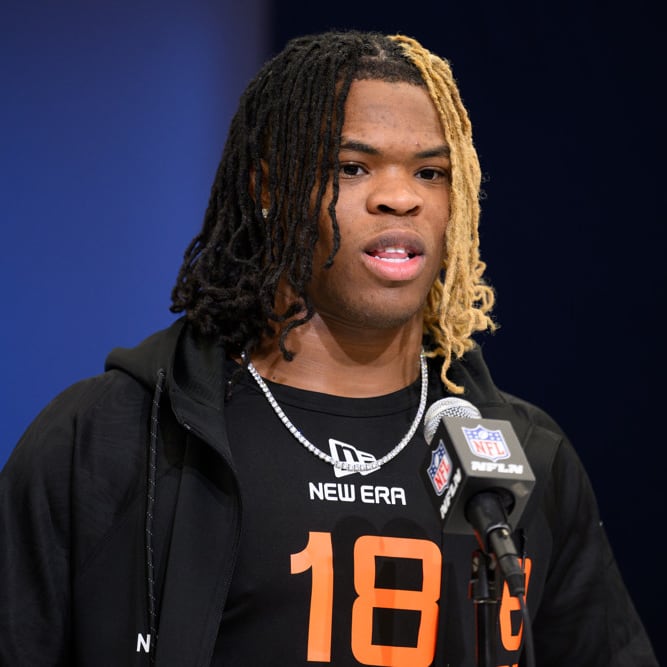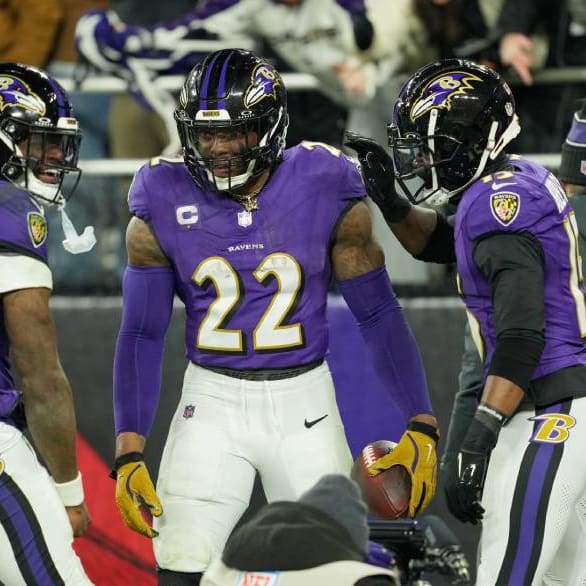It's Week 12, and you're jockeying for one of your league's final playoff spots. Of course, this week you're facing off against the top team – you know, the guy you made fun of when he took Arian Foster "too early" while you were patting yourself on the back for your pick-up of Ryan Mathews. You might be able to weather a loss, but you need a little help. You check the schedule, and your closest competition is facing off against… Snap, the worst team in the league, the guy that checked out weeks ago. You check the matchup on Sunday morning, and this joker is still starting DeAngelo Williams. Didn't he know Williams got hurt weeks ago? You give him a call, and beg him to at least start a player who's not singlehandedly supporting the soft cast industry. You hear, "Sorry man, I'm done for this year anyway. Plus, I'm out at brunch – maybe I'll check the league next week.
If you find yourself in this situation, now might be a good time to consider a keeper league – simply, a fantasy league where teams can keep certain players from year to year. Nothing strikes fear in the heart of casual fantasy players than a keeper league. Done right, it can be a lot of fun not only for owners that are competing for the title this year, but also for owners that are out of it and are looking to build for next year. And if you don't have an eye for strategy and player development (or just plain luck), you could end up doing something like trading Jamaal Charles for Joseph Addai before the season starts and wrecking your team for years to come.
So you pitch the idea at your next draft, and your buddies think it's a good idea. The only problem is no one has run, much less been in, a keeper league. How do you set up the league? Who should teams be allowed to keep? Should you allow the trading of future draft picks? These are all legitimate questions that you need to think about before you set up your league.
I currently am in five keeper leagues in four different sports, and am a commissioner in four of them. Running any sort of fantasy league can take a lot of time and dedication, but keeper leagues are a much different animal. Being a commissioner of a yearly league is like using a Showtime Rotisserie – you can just set it and forget it. League hosting sites have grown to be extremely flexible, so once you get your league up and running, things usually run fairly smoothly. On the other hand, while some sites have features that cater to keeper leagues, you're on your own for a lot of the offseason and in-season maintenance. In addition, there are a number of offline decisions that need to be made each year, each of which can make or break the league.
More than anything, running a keeper league takes a lot of patience and discretion. Many of the same time sinks of yearly leagues apply with equal force to keepers. You're still going to have to deal with the joys of collecting entry fees and penalties, adding players to rosters at two in the morning after your draft, spending your lunch breaks running free agents, and, my all time favorite, mediating trade fairness disputes from the guy in your league that EMAILS EVERYONE IN ALL CAPS. These are all very real issues that will take up your time and cause your hair to turn grey (unless of course you're Emmitt Smith). This article, however, will just focus on the issues specific to running keeper leagues.
The Keeper Format
There are so many keeper formats out there that it would be easy to do a whole article on the topic. For the sake of brevity, I'll list a few of the formats with which I'm most familiar. For the most part, the method of selecting keepers will depend on whether your league is a draft or auction league.
In draft leagues, the most common keeper format is to allow teams to keep a limited number of players in the rounds in which they were drafted the previous year. This rewards teams who take gambles on rookies or unproven players above the typical draft slot in a particular year, with the hope that those players will outperform the draft slot in future years. In a good example, in one of my leagues Michael Turner was taken in the 15th round in his last year as a backup to LaDainian Tomlinson. The next year, he could be kept a starting running back for Atlanta in the 15th. On the flip side, I once took JaMarcus Russell in 5th round. You win some, you lose some.
In a variation on that theme, some of these leagues place restrictions on how long and in what round you can keep a player. For example, it may not be fair for me to have Turner in the 15th round for the rest of his career. In this particular league, however, players could be kept for a maximum of three seasons. In other leagues, the round in which you can keep a player advances by one or two spots each year. In these leagues, if Turner were selected in the 15th round, the following year he could be kept but only in the 14th (or 13th).
Auction Leagues
For those unfamiliar with auction leagues, owners are given the same limited budget at a pre-season auction to spend on players. Part of the fun of auctions is waiting out other owners who overspend on superstars up front, and being able to outbid them later and have a more balanced lineup. In keeper auction leagues, players can be kept based on the price paid at auction the previous season. So if I pay $1 for Turner at auction one year, in some leagues I could keep him for $1 the following year (meaning that he only will use up $1 of my budget at the next year's auction).
We use one keeper auction format in a number of Rotowire staff keeper leagues that I think works particularly well. After a player's initial year on your roster (called his "A year"), you can elect to keep him the following season at the same price (his "B year"). After his B year, you elect to keep him for either one more season at the same price (his "C year"), after which he must be tossed back into the auction pool the following season, or you can give the player a long-term contract. For each year you extend the contract, you must increase the player's salary by $5. By example, assume I select Turner at auction for $2 in 2008, and keep him for $2 in his B year in 2009. If before the 2010 season I want to extend him through 2013, I would have to pay him a total salary of $17 ($5 x 3 + $2) in each of 2010, 2011, 2012, and 2013. The catch is that if I decide I don't like him and cut him prior to the end of his contract, I would lose half of his salary at auction each year until the contract expired. So there are incentives to extend long-term contracts to players who are greatly below market value, but extending a player for too long can have serious consequences if he get injured or becomes ineffective.
Dynasty Leagues
Another keeper format is referred to as a "dynasty" league, in which owners select large rosters of players and can keep many of them from year to year (thus, building a dynasty). I am in one dynasty football league in which all players can be kept until they are 30 years old; teams can elect to keep one extra player over 30 on top of that. Personally, I think the age limit in this league should be lowered (as most running backs and many receivers are no longer starting or even in the league after 30), but you get the gist. The fun of these leagues is being able to take risks on players who have not fully reached their potential, and then to follow their careers without having to worry about having to re-draft or use one of your limited keeper slots on those players each year. In one Rotowire football league, which we drafted at the yearly staff retreat in Vegas, we were each allowed to select one college player that we could keep on our roster once they made it to the NFL. While others jumped the gun and spent earlier-round picks on popular names like Leinart and Bush, I waited and took an undersized, underdog running back from UCLA then known as Maurice Drew. Too bad the league fizzled.
One common question regardless of keeper format is how many players should be kept from year to year. I have seen leagues range from those that let you keep one player per year to those that let you keep up to three quarters of your roster. As a matter of personal taste, I like leagues that let you keep more players than fewer, just to create a greater incentive to trade for prospects and gamble on upside during the season. But leagues that allow too many keepers can de-emphasize the draft and make it harder for the bottom half of the league (or, in many cases, new owners who take over for bottom half drop-outs) to contend from year to year.
The Draft
There's not too much to say about keeper league drafts. They're not any different from yearly league drafts, except that at the end of massive dynasty league drafts with forty-man rosters, a few owners who aren't as prepared as the others will get to the end of their draft boards and start to take players who were already picked, who recently retired, and so forth. But that's more of a minor annoyance than a big issue. There are, however, a few questions about draft structure that my leagues have grappled with recently, which your league should consider and settle up front.
The first is whether to use a "snake" format, in which the last pick in each round gets the first pick in the next round. Most first-time keeper leagues default to a snake format because it's the fairest structure and used almost uniformly in yearly leagues. For that reason, it makes sense to have a snake draft in year one of a keeper league as well. You should consider, though, whether in subsequent years you will want all teams to have an equal shot during the draft, or if you instead want to lock all teams into the same draft slot each round, so lower-finishing teams get earlier picks in each round. For fundamental fairness – as well as the tendency for some owners to drop out if they don't feel they have an opportunity to improve their team – I have advocated moving a lot of my leagues away from snaking after year one.
On the other hand, giving teams a benefit at the draft for finishing at the bottom of the league can incentivize teams near the bottom to tank at the end of the season get top picks. In some ways, this issue is similar to that faced by the major professional sports leagues. If a few picks are likely to be major game-changers – which may be the case in some dynasty leagues in which you can keep players unconditionally for five to ten years – it's likely to cross some owners' minds to sit out some of their better players, or just fail to rotate out injured guys, in order to lose games and get one of those top picks. In reality, I find that tanking is not as big of a concern as many make it out to be, but it still is an issue that should be given some thought.
One method is to address the issue like the NBA and NHL and have a draft lottery. I have done this in one of my leagues in which top picks are especially valuable. The bottom four teams from the previous season have 60%, 30%, 7%, and 3% chances of landing the top pick, relatively. I don't have a ping pong ball machine lying around my basement (my wife is tolerant of fantasy sports, but not that tolerant), so I use the random integer generator at http://www.random.org/integers to assign ranges of numbers to each of the teams, and generate random numbers until each of the four owners has a number selected. A different (and slightly less nerdy) way to address tanking is to institute monetary penalties for the teams that finish at the bottom of the league, with maybe an additional penalty for the last place team. This can create the headache of dealing with an additional collection at the end of the season, but even a small penalty can psychologically encourage last place teams to compete until the end of the year. A final solution I have seen is to give the first overall pick to the team that finishes in the last spot that doesn't result in a monetary penalty, and then to let the bottom teams pick right before the top few teams. In a league with twelve teams with the top three finishing in the money and the bottom three paying an additional penalty, such a draft order might be (with the numbers representing the team's place in the previous year's standings): 9, 8, 7, 6, 5, 4, 12, 11, 10, 3, 2, 1. You can play with the order a bit, but such a system greatly encourages owners finishing near the bottom of the league to stay competitive.
A final issue to settle at the time of your draft or auction is what players should be eligible. Some keeper leagues permit you to draft and keep college players or minor leaguers. This can add a little fun in that owners can speculate on whether to invest in future value over current production. If you permit this, you should consider limiting the number of these players that can be selected to keep owners from sabotaging their teams in the current year and to make sure that the draft pool is replenished in the future.
Trading
One of the primary benefits of a keeper league is that it allows teams that aren't in contention for the current year to stay involved to try and improve their team for the future. One of the primary means of doing so is by trading players with current value to teams in contention for players or draft picks with future value (known not-so-fondly as "dump trading"). Unfortunately, this one essential (and fun) aspect of keeper leagues seems to create the greatest amount of conflict among owners. Invariably, different owners will have different ideas about the future value of young, unproven players. When a top player is traded for future value, competitors often think (correctly or incorrectly) "What a terrible deal, I would have given up more for him." For those new to keeper leagues, these trades might even seem offensive – for example, there's almost no chance that Chris Johnson would be traded in a yearly league. In most fantasy football leagues, in which the last few weeks of the season dictate who wins and who loses, these trades can have tremendous impact. In my experience, nothing engenders more disagreement and tension among owners than these dump trades.
My personal philosophy is that even though your league's visceral reaction to a particular deal might be one of disgust or repulsion, do not resort to trade committees or second guessing to overturn trades. Particularly in keeper leagues, it's incredibly difficult to judge a player's future value; there are just too many variables. (If it were easy, then real general managers and scouts would always know the right moves to make.) In the world of fantasy sports, however, we all somehow know best, and if someone makes a move that helps a competitor significantly, your first reaction is likely to be negative.
That's not to say that in some leagues dump trading can't sometimes get out of control. In these leagues, it may even be a given that you need to trade for top players to compete, leading to somewhat of an arms race where the team that makes the most trades has the best chance of winning. Conversely, teams that are out of contention might feel the pressure to trade unkeepable players for anything of future value, such as mid-to-late-round draft picks, leading to serious contributors being swapped at the deadline for what feels like peanuts. Then, there's the issue of the owner who is out of contention and doesn't have enough time, who takes the first deal that is offered to him. Finally, there's always the Montreal Expos Conundrum – the case of owner that knows he's not coming back next season who trades his entire future for a shot at the money in the current season.
There are some ways to address these concerns. In auction leagues, you can institute an in-season salary cap (at a value greater than your auction budget) to prevent teams from adding a number of high-priced stars while giving up little in return. You can prevent the trading of mid-round draft picks. If you really think owners aren't doing their due diligence, you can publish all trades a few days before they become effective, and allow either of the owners to back out of the trade if they get a better offer. These are all pretty drastic measures, and I don't recommend you institute any of them in Year 1 of your keeper league. If a majority of owners in your league feel that dump trading is getting to be a problem, then would be the time to talk it through.
There are, however, two types of trades that are serious enough to consider prohibiting from the outset. The first are "rent-a-player" deals, in which an owner trades a player during the season with the understanding that the owner will have the player traded back in the offseason. The second is the trading of auction dollars or high-round draft picks, which can really inhibit teams from competing in subsequent years. These types of trades can undermine the integrity of your keeper leagues, and you should consider barring them.
Free agents
There are a few unique considerations related to free agency in keeper leagues. Should you allow players selected as free agents to be kept? Should you allow teams to pick up and keep injured players dropped by other teams? If your league uses long-term contracts, and a player on a long-term contract is dropped, should the team that picks up the player assume the contract? If the same team picks up a player that it drops, should it get the player on a new contract or still be responsible for the long-term contract? For the most part, there is no "right" way to do it – just decide what fits best for your league.
Being a Keeper League Commissioner
So now you've set up your keeper league. That was the easy part. You just wrote ten pages of rules, and now you have to enforce them. In no particular order, this includes closely scrutinizing yearly keeper lists (to make sure owners can actually keep the players they submitted in the draft slot or for the contract price they listed), enforcing year-to-year penalties (such as when players are dropped in the middle of long-term contracts), keeping track of traded draft picks, keeping track of which players on rosters are keepable and which are not, and ensuring that teams aren't picking up ineligible free agents (and unwinding those pick-ups when they happen). You're never going to have perfect compliance, but make sure that everyone knows and is familiar with the rules. If you have new owners, give them a mulligan or two. If there is an unbalanced trade involving a new owner, explain the keeper implications before letting the trade move forward.
And, of course, be flexible with your rules and consistent in your application of them. Every once in a while, during the season you'll determine that one of your rules results in unintended consequences. If that happens, consider changing the rule. Generally, for in-season rule changes the vote to change the rule should be unanimous to keep owners from voting for rule changes just because it will benefit them that season. Otherwise, wait at least until the offseason to change the rules. If a rule change affects decisions teams have already made, make the changes applicable further in the future (good examples are major changes to the draft or keeper structure). And listen to your fellow owners: if everyone supports a rule change but you, then maybe you shouldn't hold up that rule change.
Finally, the most important role of a keeper league commissioner is to make sure everyone is having fun. It may sound trite, but sometimes it makes sense to step back and remember that fantasy football is a game. If people aren't having fun, you will find that fewer owners will come back the next season. If you are heavy-handed, inflexible, or unfair, people will trust you less. This perhaps is reflected in the first task you'll have to undertake every season. Give yourself a month or two before the offseason keeper deadline to check in with all your owners and make sure you know who's coming back. It's never fun to beat down doors to try and convince a new owner to pick up a last-place keeper league team within a week of the draft. Give yourself that lead time.
Perhaps some of you have no intention of being a keeper league commissioner. That might be a wise decision. You will get to spend a little more time with your family, catch a few extra hours of sleep, and won't have to worry about looking over your shoulder at work for your boss as you make last-minute roster changes for the guy who barely missed the deadline to set lineups for the week because he was out of town. Hopefully, though, you have gained a little insight about what it takes to run a keeper league. And just maybe, after the season is over and you've gotten the email with the last standings update and received your league payment, you can take a moment and write back and say: "Hey Commish, thanks for taking the time to run the league this year, I had a great time."
Bret would be happy to hear about the trials and tribulations you have experienced when running your keeper league. Feel free to email him at bret.s.cohen@gmail.com.
Looking to place bets for your favorite team? You may be exited to know we answer questions like what is the best bonus code for betmgm?











